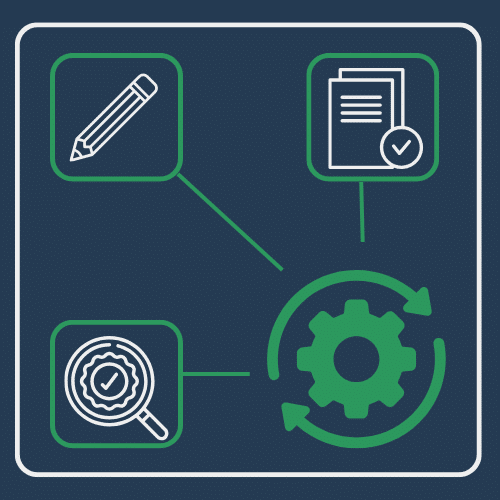Expert guide to SAP Accounting and financial close
Expert guide to SAP Accounting and Financial Close: key steps, automation and best practices for a smooth, compliant accounting close.
You are here : Home " SAP Guide " SAP Solutions "SAP Accounting and Financial Close
Pressure on deadlines, errors to be corrected at the last minute, exhausted teams, controls scattered across 12 Excel files...
A recurring challenge for finance and accounting teams in all organizations.
And yet, every month, every quarter, every year... we have to go through it.
The good news? SAP has designed a dedicated application to centralize, automate and secure this critical step in the closing process:
SAP Accounting and Financial Close, a solution integrated with SAP S/4HANA.
What is SAP Accounting and Financial Close?
Closing is much more than an accounting statement.
This is a central process in the life of a company, conditioning its financial credibility, regulatory obligations and ability to manage.
And yet, in many teams :
- Validations are manual,
- The writings are scattered,
- Coordination is laborious,
- Decisions are made on shaky foundations.
SAP Accounting and Financial Close transforms this chaos into an organized, predictive system.
It's an SAP solution integrated with S/4HANA, designed for advanced automation, document traceability and regulatory compliance.
Its goal:
👉 Reduce lead times
👉 Improving data quality
👉 Make financial management more reliable and transparent
Whether you're an accountant, controller, CFO or SAP consultant, this solution enables you to :
- Follow each stage of the closing process, with clearly defined responsibilities
- Automate recurring entries, provisions and reconciliations
- Justify discrepancies with centralized, integrated documents
- Produce compliant, up-to-date and predictive financial reporting
In short, SAP transforms a manual, dispersed process into a fluid, automated and structured management system.
And in the next section, we go into more detail about its features.
Key features of SAP Accounting and Financial Close
SAP Accounting and Financial Close is more than just a checklist.
It's an advanced SAP application that structures the accounting closing process around rigorous, automated financial management, perfectly integrated with the SAP S/4HANA environment.
Here are the key functional bricks that make up this strategic solution.
General and auxiliary accounting (GL/AP/AR)
It all starts with the basics: bookkeeping.
SAP provides a native accounting structure:
– GL (General Ledger): management of entries, balances, periodic closures
– AP (Accounts Payable): monitor supplier invoices, due dates, payments
– AR (Accounts Receivable): customer invoicing, collections, reminders
Each module is interconnected. Result: less re-keying, more consistency and complete traceability.
Automation of recurring entries and provisions
Enter depreciation, provisions for vacation pay or accrued expenses manually?
It's all over now.
SAP enables you to :
- Program recurring entries with automatic generation
- Integrate predictive accounting models, depending on the type of transaction
- Track adjustments in real time, with configurable alerts
The result: massive time savings and reduced risk of error, with accounting teams more focused on performance analysis.
Automated inter-company reconciliation
In groups with several entities, inter-company entries quickly become a nightmare.
SAP offers a automated inter-company reconciliation :
👉 Entries are compared in real time
👉 Discrepancies are identified automatically
👉 Supporting documents are attached to each line.
A major asset for centralized financial management in large groups or in post-merger environments.
Closing period management and approval workflow
Closing the books involves a structured sequence of steps.
And in SAP, every step is traced, controlled and validated.
– Period opening and closing centralized
– Approval workflows customized (by entity, department, type of entry)
- Progress tracking with alerts and notifications
Period opening and closing are centralized and visible to all stakeholders.
Automatic notifications and alerts keep track of progress, so you never lose track.
Integration of local and international accounting standards (IFRS, GAAP)
Whether you're based in France, the US or a listed group, you have to comply with strict standards.
SAP enables :
- Manage several accounting systems in parallel
- Automate the necessary restatements (IFRS vs. local GAAP)
- Align internal reporting with regulatory requirements
All this without the need for multiple files or manual reprocessing.
Each feature has a purpose: increase precision, safety and speed.
And when this architecture is based on SAP S/4HANA, it takes things up a notch.
Financial closing with SAP S/4HANA
SAP S/4HANA has not simply "digitized" the closing of accounts.
He has rebuilt around intelligent architectureby combining :
real-time data
automated processes
continuous piloting
Here's how this transformation is playing out in your organization.
Now that the groundwork has been laid, let's take it a step further with theadvanced automation of the closing process.
Optimizing and automating the closing process
SAP Accounting and Financial Close isn't there to "save you a little time".
It is designed to change the rules of the financial management game:
- Shorten lead times
- Automate low value-added tasks
- Making controls more reliable and support financial decision
Here are the advanced technological building blocks that make this transformation possible in an SAP S/4HANA environment.
🧭 SAP Financial Closing Cockpit: centralized closing management
The Closing Cockpit is the command center of the closing process.
It allows you to :
- View all tasks to be performed (by entity, period, type of entry)
- Track progress step by step, with clear status and notifications
- Assign responsibilities to each member of the accounting or finance team
- Direct access to support documentsvalidations and comments
You move from scattered, manual management to centralized, controlled, structured orchestration.
A real lever for organizational performance.


🤖 RPA and artificial intelligence for repetitive accounting tasks
Some manual actions are repeated in every cycle:
- Entry of standard entries
- Verification of supporting documents
- Consistency check on accounts
SAP makes it possible to integrate RPA (Robotic Process Automation) robots to automate these repetitive operations.
And that's not all: thanks to artificial intelligence, you can also :
- Detect anomalies in accounting flows
- Automatically propose provisions or reclassifications
- Prioritize sensitive accounts to be analyzed at the end of the period
Technology becomes an intelligent co-pilot for finance teams.
📋 Using SAP Task Management and SAP BTP Workflow
With SAP Task Management, you can :
- Create customized validation workflowsadapted to your business rules
- Monitor lead times, follow-up with managers automatically
- Integrate tasks with other SAP applications (FP&A, Treasury, Compliance...)
The SAP BTP Workflow module adds even greater flexibility for modeling customized processes.
An advantage for organizations with complex or evolving flows.


👥 Collaboration between teams (CFO, accountants, management controllers)
Financial closure is not the job of a single department.
It's a cross-functional operation, involving the CFO, accountants, controllers, and sometimes the legal or HR departments.
SAP enables you to :
- Share information in real time between teams
- Clearly assign roles and responsibilities
- Track all validations, comments and adjustments
Fewer emails. Fewer grey areas.
More fluid collaboration and shared responsibility.
Automation doesn't replace people.
It frees finance teams from repetitive tasks, so they can concentrate on analysis, strategy and decision-making.
But you still need to know where this solution excels... and where it may have its limits.
The advantages and limitations of this solution
SAP Accounting and Financial Close is a robust, structured solution designed to automate, centralize and increase the reliability of the accounting close.
But like any strategic tool in the SAP S/4HANA ecosystem, it has both advanced strengths... and areas to watch out for during implementation.
SAP Accounting and Financial Close excels in :
- Multi-entity
- Multi-standard
- Highly regulated
- With high accounting volumes
But it requires a certain level of financial and digital maturity to deliver its full potential.
Deployment and integration of SAP Accounting and Financial Close
An SAP project, especially when it involves financial closing, can't be set up like a simple office application.
You need to think in terms of information system architecture, connections between modules, role assignment, workflow automation...
And above all: knowing how to integrate this solution into the company's overall ecosystem.
Integration with SAP S/4HANA Central Finance
If you use SAP Central Finance, SAP Accounting and Financial Close can draw directly on consolidated financial data from your various ERP systems.
This allows :
- A centralized fencing on a single system
- A group visibility essential for reporting
- A reduction in the number of manual control points
It's an ideal solution for multi-entity groups, post-merger environments or companies undergoing transformation.
Connections to SAP Treasury, FP&A and Tax Compliance
SAP Accounting and Financial Close doesn't live in silos.
It is designed to integrate naturally with other solutions in the SAP Finance landscape:
- SAP Treasury to synchronize financial flows with closing stages
- SAP FP&A (Financial Planning & Analysis) to bring budget forecasts into line with actual results
- SAP Tax Compliance to guarantee tax compliance as soon as accounting entries are generated
The result: an interconnected organization, less re-keying, fewer errors, greater fluidity.
Cloud or hybrid architecture (SAP HEC, RISE with SAP)
SAP offers several deployment options, depending on your requirements:
- Public cloud via SAP Analytics Cloud or RISE with SAP
- Private cloud via SAP HEC
- Hybridfor companies wishing to retain certain on-premise systems
The choice will depend on your IT roadmap, your regulatory requirements, and your willingness to migrate to SAP's intelligent cloud.
Regardless of the model chosen, successful deployment depends on :
- A experienced partner
- A clear mapping of financial flows
- A committed internal sponsor (ideally CFO or finance director)
SAP Accounting and Financial Close is not a plug-and-play tool.
It's a strategic, high value-added solution... provided it's carefully implemented.
Comparison: SAP Accounting & Financial Close vs. other solutions
Closing accounts is critical to a company's financial performance.
And there are several solutions on the market to meet this need: SAP, Oracle, BlackLine, Trintech, or even tools developed in-house.
So how is SAP Accounting and Financial Close positioned in this competitive landscape?
Here's a structured comparison, to help you understand the strengths and limitations of each option.
Key features
| Functionality | SAP Accounting & Financial Close | BlackLine | Oracle FCC | Excel/Internal Dev |
|---|---|---|---|---|
| Integrated management of GL, AP, AR | ✔️ (native S/4HANA) | ❌ | ✔️ | Variable |
| Automated entries | ✔️ advanced | ✔️ | ✔️ | ❌ |
| Intercostal reconciliation | ✔️ automated | ✔️ | ✔️ | ❌ |
| Continuous fence | ✔️ (continuous accounting) | Partial | Partial | ❌ |
| Reporting / FP&A integration | ✔️ via SAC | Partial | ✔️ | ❌ |
| Traceability and auditability | ✔️ complete | ✔️ | ✔️ | ❌ |
When should you choose SAP Accounting and Financial Close?
- You already work in an SAP environment
- You're looking for deep, long-lasting automation
- You need to centralize closing for several entities or countries
- You have a Cloud roadmap (SAC, RISE with SAP, Central Finance)
For an isolated SME or a company with no SAP environment, a solution such as BlackLine or an in-house architecture may suffice.
But for a structured, growing, multi-entity or multi-country organization, SAP remains one of the most powerful, integrated and scalable solutions on the market.
SAP Accounting and Financial Close is more than just a toolbox.
It's a complete methodology, a strategic infrastructure, at the service of accounting and decision-making performance.
But this kind of tool only delivers value if you're well trained.
PS: Would you like to become an expert in SAP solutions, including accounting and financial closing?
At Expert Training Center, we take you step by step through :
- Practical, progressive e-learning courses
- Case studies from the field
- Support for rapid skills upgrading, even without a technical background
📌 Discover our training courses
SAP expertise training

👤 Who is this training for? Designed for SAP consultants with previous experience who want to deepen their expertise and move into higher value-added positions.
🎯 What is the purpose of this training? Our aim is to enable you to rapidly upgrade your skills and keep up to date with the latest developments in the field. Combining cutting-edge content, application and personalized follow-up.
🚀 What learning method do you use? Platform integrating training content created by our network of SAP experts, an SAP AI agent, personalized Learning Paths, and support from a community of experts.

